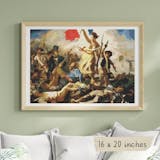The Creation of Adam: Michelangelo's Divine Masterpiece
God’s about to give Adam the spark of life… but Adam looks like he just wants five more minutes of sleep.

Michelangelo Buonarroti—yes, that Michelangelo, the Renaissance rock star with a chisel in one hand and a paintbrush in the other—gave the world plenty of jaw-dropping masterpieces. But none has captured imaginations quite like The Creation of Adam. Painted on the ceiling of the Sistine Chapel in Vatican City around 1512, this fresco isn’t just an extraordinary display of artistic genius—it’s also a visual mic drop on the themes of life, divinity, and humanity’s eternal connection to something greater.
A Ceiling Like No Other
Back in 1508, Pope Julius II decided Michelangelo should swap his sculptor’s hammer for a paintbrush. Michelangelo wasn’t thrilled—he famously considered himself a sculptor, not a painter—but he took on the challenge anyway. Four years (and a sore neck) later, the Sistine Chapel ceiling became a wonder of the world. Among its nine central panels depicting stories from Genesis, The Creation of Adam sits front and center. It brings to life that biblical moment when God gives Adam not just existence, but a spark of something bigger—soul, intellect, and the promise of humanity.
Fingers Almost Touching: A Study in Connection
The scene is simple yet unforgettable: God, wrapped in flowing drapery and surrounded by a lively entourage of angels, stretches His arm toward Adam. Adam, lounging against the barren earth, lazily reaches back. Between their nearly-touching fingertips is a gap so small yet so powerful that it has inspired centuries of debate. Is it the spark of life? The dawn of human consciousness? Or maybe just history’s most dramatic “almost high five”?
Michelangelo’s vision of God was groundbreaking. Instead of a distant, untouchable figure, He appears strong, dynamic, and startlingly human—His body echoing Adam’s. The divine entourage around Him pulses with energy, while Adam appears beautifully formed but inert, as if waiting for that vital jolt only God can provide.
Layers of Symbolism
It’s not just pretty fingers and buff Renaissance bodies—Michelangelo packed in meaning. Many see the hands as the symbol of life itself. Some scholars even suggest the shape of God’s cloak looks suspiciously like a human brain, hinting that God’s greatest gift might be intellect and self-awareness.
On one side, God’s world bursts with swirling fabric, color, and vitality; on Adam’s side, the landscape is empty, almost unfinished, a canvas awaiting its divine spark. The contrast makes their connection even more dramatic.
Michelangelo’s Craft and Lasting Influence
What makes the fresco timeless is Michelangelo’s technique. His deep understanding of anatomy, movement, and light brought the figures to life in a way few artists have ever matched. He could carve emotion out of posture and fill silence with tension. And let’s be honest: those hands alone are more famous than most entire paintings.
Over the centuries, The Creation of Adam has been endlessly reimagined—in books, movies, cartoons, memes, and even advertising. From scholarly debates to cheeky pop-culture references, it continues to capture both reverence and imagination.
Why It Still Matters
The Creation of Adam is more than religious art—it’s the Renaissance distilled onto plaster. It celebrates human potential, creativity, and the idea that we’re forever reaching toward something higher. Michelangelo managed to freeze in paint a moment that feels both intimate and cosmic, ancient and utterly timeless.
The next time you look up at those two famous hands reaching across the void, remember: it’s not just Adam waiting for life—it’s all of us, caught in that eternal spark between what we are and what we might become.








